Fitting a snake in a tank doesn’t mean that a snake that is the length of the tank is capable of living in your setup. We’re going to analyze 6 snakes that not only fit in a 10-gallon tank but can have a good life in a 10-gallon tank.

Most snake specialists will recommend that a 10-gallon setup should not be used for adults. It is often used for juveniles or to keep prey items alive but picking a serpent for your setup needs to be a calculated move. All snake enclosures must have a lid that’s secured on them. Freshwater needs to be provided daily as drinking water and for most snakes to soak in when shedding.
Smaller enclosures require more frequent and thorough cleanings, but the size makes them appealing as they won’t take over your whole space. So, what are 6 snakes that fit into a 10-gallon tank?
6 Snakes That Fit In A 10 Gallon Tank
These are the 6 snakes that can safely live in a 10-gallon tank:
- Rosy Boas
- Male Kenyan Sand Boas
- Worm Snakes
- African House Snakes
- Rubber Boas
- Green Snakes
1. Rosy Boas
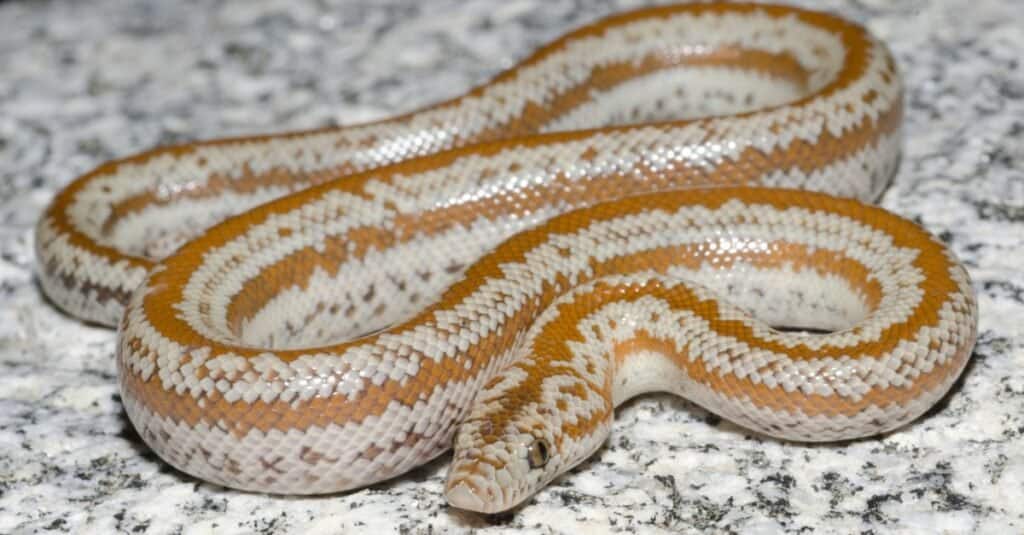
Rosy boas like to coil, which makes them suitable for a smaller tank.
©Jason Mintzer/Shutterstock.com
The general rule of thumb is that the tank needs to be twice as long as the snake kept in it, so a snake that averages a few feet in length isn’t usually recommended. Some think rosy boas are too large for a ten-gallon tank, but they’re almost always coiled up.
Rosy boas like to live in temperatures no higher than 85 and no lower than 80. They need a place to hide, and pet stores carry all kinds of options for your tank.
Securing the lid tightly is a must if you’re going to keep these snakes. They’ll figure a way out of any hole or crevice you give them. Paper towels are an excellent substrate.
2. Male Kenyan Sand Boas
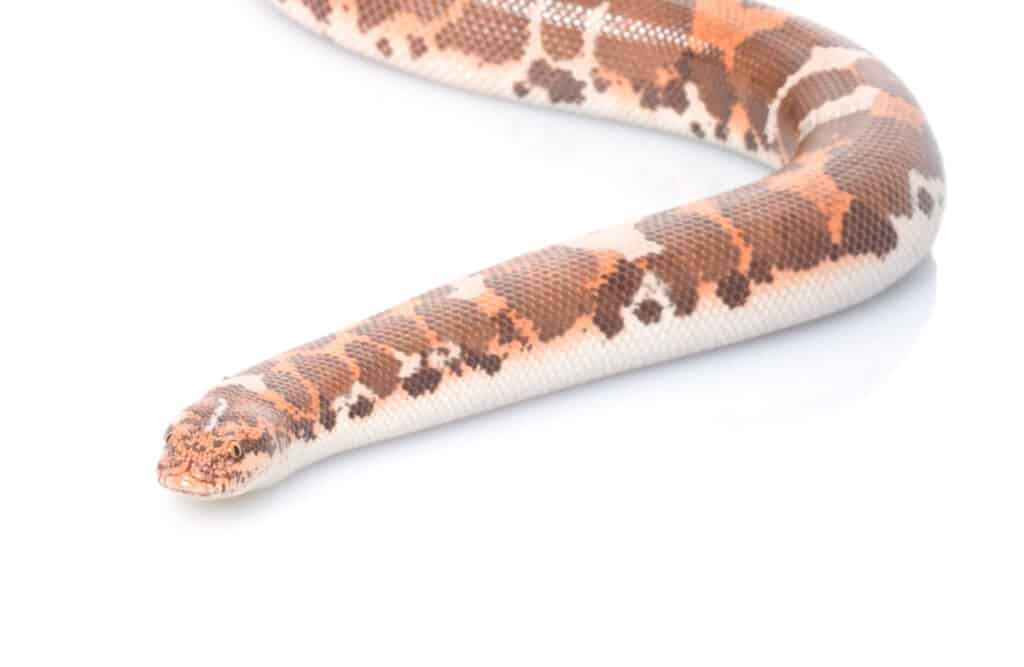
Male Kenyan sand boas work in a 10-gallon tank.
©iStock.com/Natalie Ruffing
Male Kenyan sand boas are much smaller than their female counterparts, so while they’re suitable for a 10-gallon tank, the females need at least 20 gallons.
Burrowing needs to be considered when setting up a Kenyan sand boa’s home. They spend most of their time hiding. So if you’re looking for a snake you see constantly, this might not be the best choice.
Don’t put heavy things in the tank that could settle when dug under because they can crush your pet. Use newspaper, sand, or coconut mulch while steering clear of gravel.
Kenyan sand boas need two kinds of heat in their vivarium. One side will need to be 80 degrees during the day and about 75 degrees at night, though it’s ok if this fluctuates a degree or two in either direction. The hottest part of the tank needs to be about 95 degrees.
Providing this kind of warmth is done through a heating pad on at least one side of the tank. They also need an incandescent light that will simulate the sun during the day by keeping the enclosure bright and warm and then dark and cooler.
These snakes are a popular choice for first-time snake owners.
3. Worm Snakes
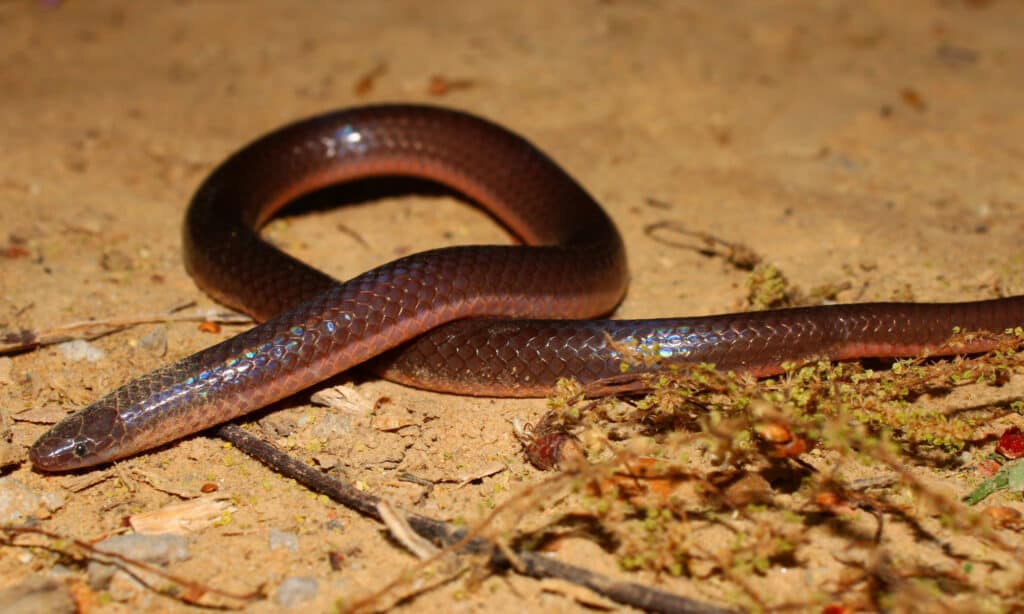
Worm snakes grow up to a foot long, making them good for a 10-gallon tank.
©Jason Patrick Ross/Shutterstock.com
Worm snakes are not the ideal pet for beginners because they have a lot of special needs. Even though these snakes look like earthworms, they make a regular habit of eating earthworms.
They’re perfect for a smaller enclosure because they only grow up to a foot long. Like most of the snakes on this list, they’ll need the appropriate substrate for proper burrowing. Since they are so little, it is possible to grow plants in the enclosure.
Perches for basking are recommended as well as well-placed hiding spots. Don’t plan on handling this snake as it won’t do well with it. A terrible smell will be released when this shy snake is disturbed.
4. African House Snakes
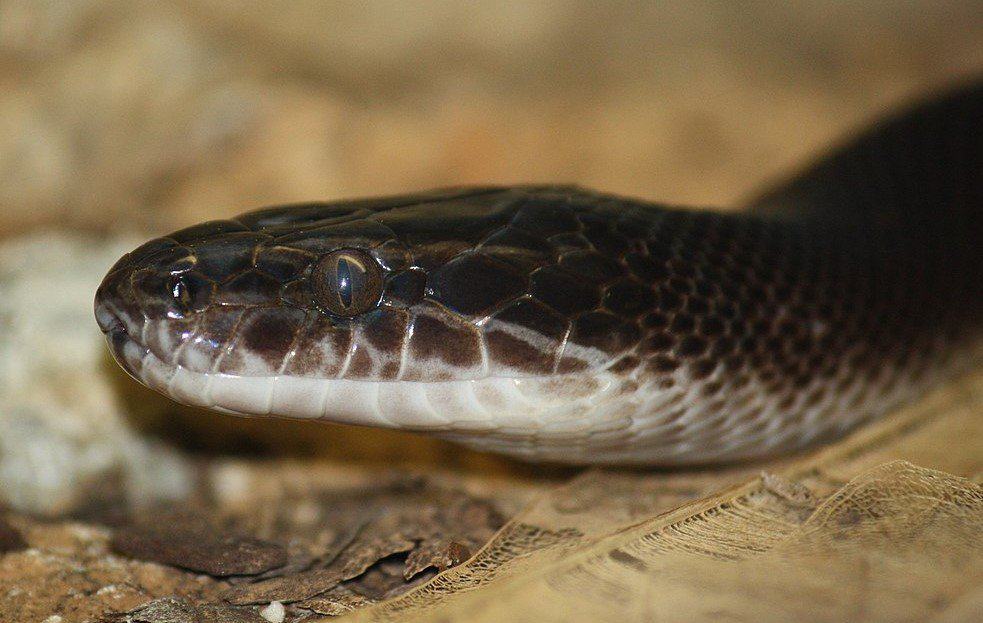
African house snakes can be in a 10-gallon tank if you provide tree branches.
African house snakes are also burrowers, so they need the appropriate substrate: use newspaper and paper towels. Beech or Aspen chips will work as well.
There should be some tree-like branches in your tank since African house snakes like to climb. The hot side of their tank should hover around 90 degrees, while the cool side can fluctuate between 70 and 80 degrees.
You will need to monitor the humidity in the tank. It should always be between 30% and 50%. Keeping a water dish in the tank is suitable for the snake and the humidity level. It’s also a good idea to spray a little water over the tank if the humidity is dropping too low.
5. Rubber Boas
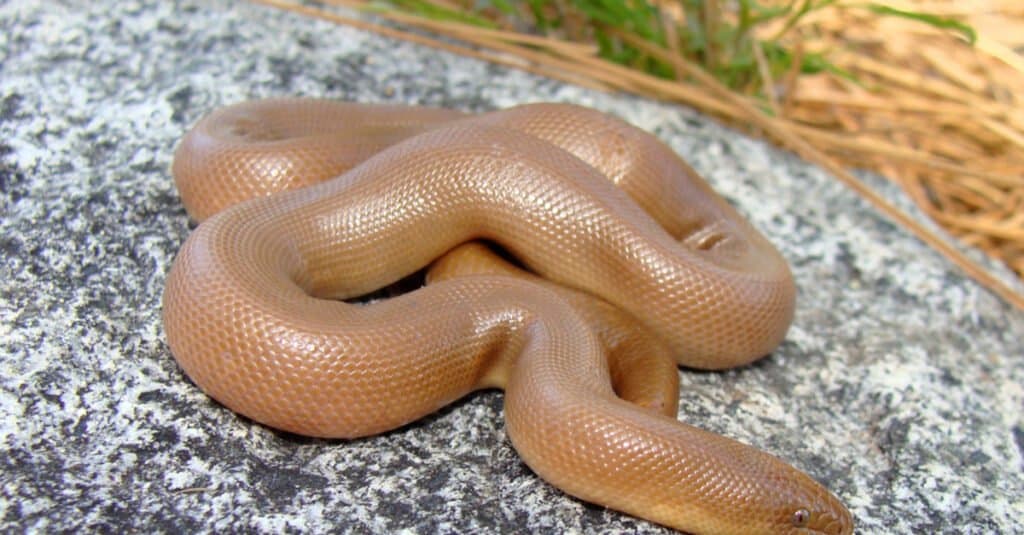
Rubber Boas are friendly and fit in a 10-gallon tank.
©Matt Jeppson/Shutterstock.com
They can be hard to find, but rubber boas will work well in a 10-gallon tank. Friendliness is their best trait as they can look a little dull. They take well to being handled and are considered quite docile.
Most states allow people to capture these snakes in the wild, which is how most in the pet trade are found. They aren’t bred in captivity much, but it’s still possible to find some breeders out there.
It’s likely their lack of visual finesse that makes them unpopular despite their stellar personalities. They like to hang out in small burrows, and if your snake is scurrying around during the day, you need to provide it with more hiding spots.
These snakes are escape artists, so the tank needs to be extra secure.
6. Green Snakes
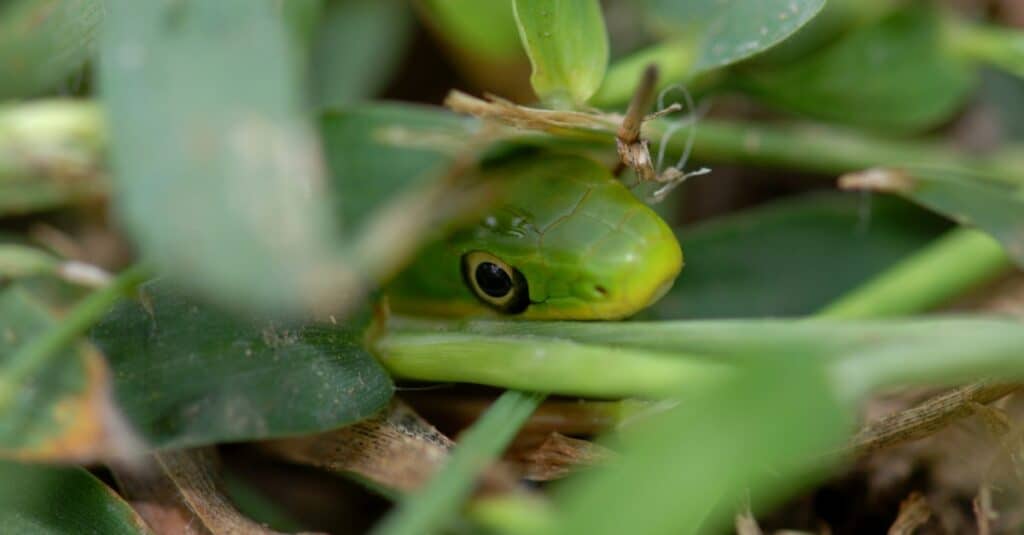
Green snakes fit in a 10-gallon tank but are not recommended for beginners.
©iStock.com/Shoemcfly
The rough and smooth green snake can use a 10-gallon tank if you’re able to give it some vertical climbing spaces that are still enclosed. Otherwise, skip this one as a pet for now.
This snake requires a little knowledge of snake handling, and it isn’t recommended for beginners. Quiet spaces are its preferred habitat since it is shy. Its striking appearance makes it a popular pet choice, nonetheless.
Green snakes are insectivores which means almost all of their diet is insects. They eat spiders, crickets, moths, caterpillars, spiders, and worms in the wild. Their meal should be no wider than the thickest parts of their body.
Since these arboreal snakes drink water that drops off of leaves in nature, their enclosure will need to be misted every day so they can drink from leaves. They’ll rarely drink from standing water sources. Providing moss as a substrate is a good idea for moisture retention.
Summary Of The 6 Snakes That (Comfortably) Fit In A 10-Gallon Tank
| Number | Snake | Tank Size & Decor |
|---|---|---|
| 1 | Rosy Boas | Curling up lets them fit in 10-gallon tanks |
| 2 | Male Kenyan Sand Boas | Males can be in 10-gallon tanks, females will need larger |
| 3 | Worm Snakes | Can be smaller tanks but extra space allows for decor |
| 4 | African House Snakes | Include branches for this climber |
| 5 | Rubber Boas | Secure this tank well, these snakes like to escape |
| 6 | Green Snakes | 10-gallon minimum with vertical space |
Other Animals That Can Fit Comfortably In A 10-Gallon Tank
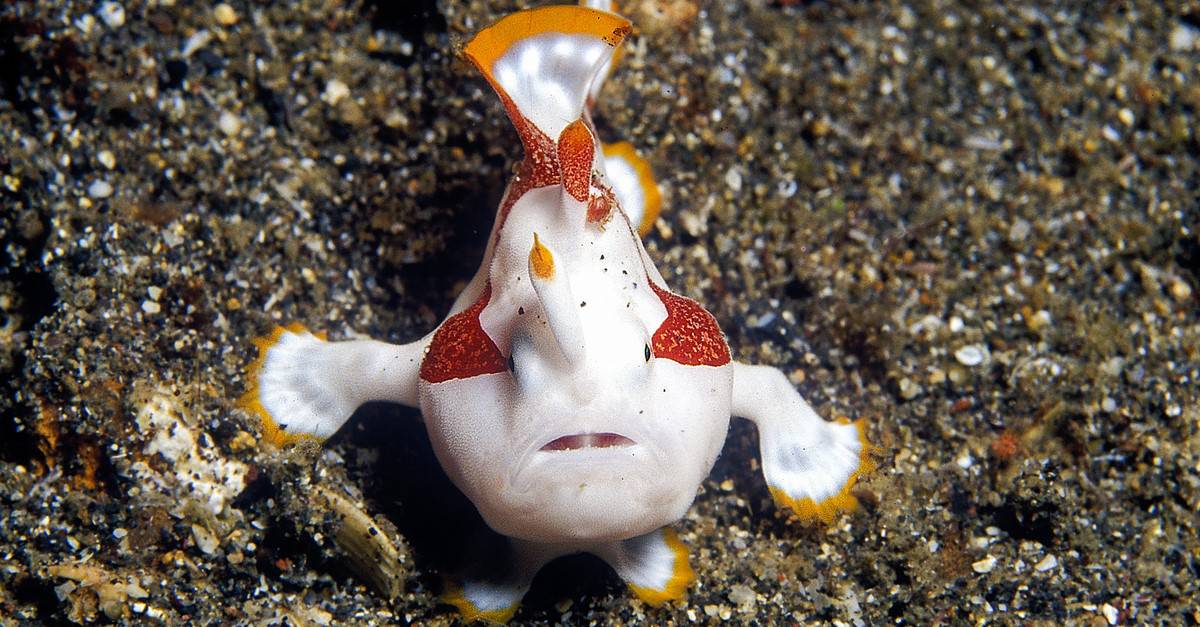
Clown frogfish, found in Lembeh, Indonesia, should only be in tanks with others of its kind.
©Jack PhotoWarp/Shutterstock.com
Frogfish are some of the many beautiful species that if you decide to bring them home, will need to have their own tank as they are ambush predators and will lie in wait to catch other fish. Capable of engulfing animals close to their own size, they do not make the best tank mates with others, and having a species-specific aquarium is better for the health of the frogfish – and of course the lives of the fish around it! Although these fish generally don’t move around much, they do like to perch and blend in with their surroundings, so you should include a variety of soft coral, rocks, sea sponges, and macroalgae. While they are relatively easy to take care of, they do require real food, not pellets, and some will only eat live food.
There are several types of lizards that would be comfortable in a 10-gallon tank. The most popular type is the leopard gecko. These lizards typically grow to about 6-10 inches long. However, they can thrive in smaller enclosures such as 10-gallon tanks with proper care and attention. Leopard geckos enjoy a variety of live insects for food and should have access to hiding spots within their enclosure, such as logs, rocks, or plants, so they feel secure from predators when resting.
Another type of lizard suitable for a 10-gallon tank is the crested gecko (Rhacodactylus ciliatus). This species was thought to be extinct until it was rediscovered in 1994 on Grand Terre Island off New Caledonia. Crested geckos are nocturnal creatures and can reach up to 8 inches long, making them ideal candidates for small terrariums like those found in 10-gallon tanks. They primarily feed on crickets, mealworms, and other insects but may also take some fruits or vegetables if offered occasionally as treats. Additionally, these lizards require plenty of foliage inside their habitat both for climbing purposes and providing humidity levels appropriate to their needs through misting twice daily with water mixed with calcium powder supplements periodically throughout the year.
The pygmy chameleon, also known as the stump-tail chameleon, is not an active climber but does well with an area that is spread out horizontally. As a tiny lizard that only reaches up to 4 inches in length, they are not an easy reptile to have as a pet due to their sensitivity to their surroundings and males should never be kept in the same tank as this can result in fighting. The pygmy requires UVB lighting, lots of moisture, and substrate conditions. Additionally, to make sure this little reptile does not get stressed, his tank should have plenty of adornment in the form of vines, foliage, and little branches. The pygmy chameleon is an insectivore and should be fed a wide variety of insects.
The photo featured at the top of this post is © iStock.com/Shoemcfly
Discover the "Monster" Snake 5X Bigger than an Anaconda
Every day A-Z Animals sends out some of the most incredible facts in the world from our free newsletter. Want to discover the 10 most beautiful snakes in the world, a "snake island" where you're never more than 3 feet from danger, or a "monster" snake 5X larger than an anaconda? Then sign up right now and you'll start receiving our daily newsletter absolutely free.
Thank you for reading! Have some feedback for us? Contact the AZ Animals editorial team.







